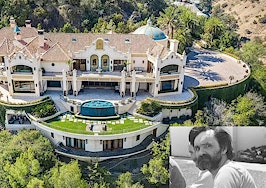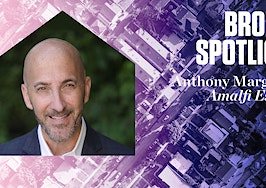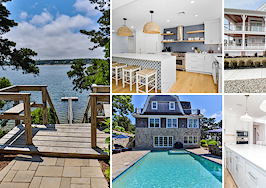Developer Nile Niami’s dream, if you could believe it, was actually even more hallucinatory than what a handful of prospective buyers saw when they began bidding on “The One” at an auction in March.
Nestled in the foothills of the Santa Monica Mountains in Bel Air, the gleaming white, 105,000-square-foot structure was originally envisioned as a vessel for museum-like rooms of live jellyfish, fresh flowers, a semi-frozen ice bar — then all the rage in the early aughts — a candy emporium and a fully-stocked, in-mansion nightclub, among other delights for the world’s 1-percenters.
By the time the home, if you can really call it that, wound up in bankruptcy court last year, all but the candy room and nightclub had been stricken from the development, but what remained was still extravagant by any measure: 21 bedrooms, 49 bathrooms, a moat and 360-degree views of the Pacific Ocean, downtown Los Angeles and the San Gabriel Mountains. Goodbye aquarium, floristry and ice bar; hello spa, bowling alley and cigar lounge.
Yet what was once billed as America’s most expensive home fell short when it was sold on March 2 to the highest bidder for $126 million, a dramatic $374 million reduction from an initial ask of $500 million.
At such Icarus-level heights, what did those numbers really mean to the five undisclosed bidders from the United States and New Zealand who vied for the property? And after all was said and done, how do buyers, sellers and real estate agents even distinguish a $500 million palace from a $126 million mansion, be it “The One” or one of the many other ones commanding north of eight figures?
“A lot of billionaires have egos,” Anthony Marguleas of Amalfi Estates in Los Angeles told Inman, matter-of-factly. “And a lot of these properties are so unique that they’re hard to put a price on it. Because of that, a lot of times they’re setting new price points. Like when they built ‘The One,’ if you’re building one of the largest houses in California, who’s to say what the value is?”
To most, the eight- and nine-figure price tags — a Palm Beach spec home for $50 million here, a Manhattan penthouse for $190 million there — boggle the mind. Amid listing descriptions that blur the senses with talk of 360-degree ocean views, imported Italian marble finishes and 600-bottle wine rooms, at a certain point, it all begins to seem insanely expensive and impossible to clearly define.
But agents who specialize in these top-tier properties say the defining factors between them can be broken down into several key components, even when there are few comparable properties at such a pie-in-the-sky price point. From factors including the number of flat, usable acres it offers to the existence of hospital-grade emergency rooms and military-grade security, a handful of features distinguish the truly extravagant from the merely luxuriant.
Size, location, security and privacy, uniqueness, pedigree and investment potential are the primary attributes that distinguish a $50 million asset from a $150 million kingdom, luxury agents told Inman.
“When there’s very few comparables, it’s challenging to come up with a valuation,” Marguleas added. “And it’s less of a science and more of an art.”

Anthony Marguleas | Amalfi Estates
Size
Among the agents Inman spoke with, lot size or the home’s square footage were factors that, without a doubt, would most significantly impact the price of a home in this ultra-luxury bracket.
“The acreage is definitely a factor,” Marguleas said of markets in Southern California. “The properties that are selling in the $50 million [range] tend to be a little bit smaller.”
“When I say acreage, I’m really talking about more flat, usable,” he clarified. “There may be like 10 or 15 acres somewhere, but if only one acre is flat, it’s not going to have the same price point.”

Steve High | Villa Real Estate
In Orange County where Steve High of Villa Real Estate operates, in addition to ample acreage, properties need to have a number of remarkable features to move the needle beyond the $50 million price range, he said.
“A $70 million house I sold was on an acre of oceanfront in a gated community in what we would consider probably the most prestigious gated waterfront community, and that’s what really brought it to that tip-top dollar,” he explained. “The house was big, but I think really it was more about the land and being on the water in the private, gated community to get that higher price level.”
On the square footage side, Marguleas pointed to “The One,” which, at twice the size of the White House, is one of the largest single-family residences ever built. But when properties exceed even 10,000 square feet, that can typically bump them into a higher price point, he said.
“Most of the homes that are selling are going to be between 10,000- and 20,000 square feet when they hit those price points, because you don’t really need homes that are 100,000 square feet — I mean, that’s a different category.”
Location
A luxury home that has a seriously enviable location — think three or more sides surrounded by the ocean, a private golf course on the property, sweeping 360-degree mountain views or steps away from Central Park — is the type of property that can reap $150 million.
“The One,” for instance, encompasses a number of these features, with 360-degree mountain, ocean and city views rolled into one.
And anything that potentially makes that location less than perfect can knock down the price.

Sally Forster Jones | Sally Forster Jones Group
“If there’s any imperfection or blemish — there’s a rooftop in the way of their views — anything like that is a critical point,” Sally Forster Jones of the Sally Forster Jones Group in Beverly Hills said.
Security and privacy
“Security rooms are critical right now,” Forster Jones said. “It’s definitely become more of an issue in recent years. The world is a complicated place and high-net-worth individuals in particular feel like they really want that security.”
From a long driveway, to guards, to gated properties and safe rooms, Forster Jones said $150 million properties have it all, whereas a $50 million property might just be gated with a security camera.
Erin Sykes, of Nest Seekers International in New York and southern Florida, said that she’s seen military-grade infrared monitoring devices at some ultra-luxe homes, multiple security guards roaming the property 24/7 and sometimes even double-gates surrounding the property as an extra buffer.
High added that issues that were exacerbated during the pandemic have led more of his clients to prefer gated communities than non-gated ones.
“I think it just has a lot to do with what we’ve been through with the coronavirus,” High said. “And, I hate to say it, but the homeless issues and people feeling less security with some of the protests that we saw last year. People really want security and protection, so the gated communities are definitely in high demand in my marketplace.”
Uniqueness
Once properties climb the ladder to around the $150 million range, buyers expect them to be one-of-a-kind, Forster Jones told Inman.

Erin Sykes | Nest Seekers International
“The fact that it is almost not replaceable makes it more valuable,” she said. “They do not want anyone to come visit and say, ‘Oh, I’ve seen a home that looks like this before.’ They want theirs to be the only one that there is — there’s no one else that has anything that really looks like this.”
For instance, one such ultra-high-end home Forster Jones has encountered before has a surgery center built into it so that if any resident needs a medical procedure done, it can be done in the privacy of the home, out of reach from prying eyes.
“It’s all about differentiation,” Sykes said. “If that means a 100-car garage, that becomes a selling point. If that means you have a sunset pool and a sunrise pool and a jacuzzi off of the master as well as an entertaining area … all of those types of things.”
Pedigree
Whether it’s the name of the architect or a former owner of historical significance, Forster Jones said the pedigree associated with the home is another factor that helps push it into ultra-high-end territory.
“Having a name brand architect that’s well-regarded is important,” she said. “It’s the pedigree, it’s the architect. It’s the history, if it’s an older estate, the history of who lived there, who visited the property.”
Sykes clarified that typically, at the approximately $150 million level, homes either fall into two opposite ends of the spectrum, where they’re either brand new and breaking barriers in design (like “The One”), or ornate, old properties that have historical significance (like the Playboy Mansion).
“You’re looking at really two extremes,” she said. “One is something that is ultra-historic and really has a story, it’s part of the culture, and it’s a pinnacle of a community. Or, you’re looking at brand new construction that really pushes the limit of what we can do engineering-wise in 2022.”
“The Playboy Mansion, for $100 million, sold a couple of years ago,” Marguleas pointed out. “You have the Hearst Estate that we sold [for $63.1 million at auction in 2021]. Definitely significant. They’re irreplaceable properties that were built in the ’20s.”
Investment potential
Many $150 million properties in Manhattan — typically new, high-rise condos — typically get help commanding their price from foreign investors who are looking for someplace relatively safe to hold their money, Sykes said.
“They’re looking at purchasing as a safe deposit box, because they’re coming from China or Saudi Arabia or Latin America, and they’re looking for their assets to be held in a stable position, because investing in their own countries is inherently unstable,” Sykes said.

Cody Vichinsky | Bespoke Real Estate
“So they may be buying a $150 million penthouse on Central Park South that could only be worth $90 million when they go to exit in a few years, but to them, that’s still a better return.”
Cody Vichinsky of Bespoke Real Estate in the Hamptons agreed that as buyers approach the $150 million level, many are looking at the property more as an asset to be invested in than a place to raise a family.
“The air is very thin [at that price point],” Vichinsky told Inman. “There’s only so many people on the planet that can obviously afford [homes more than $100 million] but wouldn’t desire to purchase them even if they have the capability to do so. So more than anything, it’s about really appealing to the investment profile at that level as an asset allocation more than it is, in my opinion, ego.”
“There’s a lot of billionaires out there who own properties, most of which do not own $100 million-plus homes,” he added. “And it’s not because they can’t afford it.”













